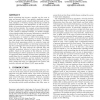Free Online Productivity Tools
i2Speak
i2Symbol
i2OCR
iTex2Img
iWeb2Print
iWeb2Shot
i2Type
iPdf2Split
iPdf2Merge
i2Bopomofo
i2Arabic
i2Style
i2Image
i2PDF
iLatex2Rtf
Sci2ools
ACSAC
2010
IEEE
2010
IEEE
Detecting spammers on social networks
Social networking has become a popular way for users to meet and interact online. Users spend a significant amount of time on popular social network platforms (such as Facebook, MySpace, or Twitter), storing and sharing a wealth of personal information. This information, as well as the possibility of contacting thousands of users, also attracts the interest of cybercriminals. For example, cybercriminals might exploit the implicit trust relationships between users in order to lure victims to malicious websites. As another example, cybercriminals might find personal information valuable for identity theft or to drive targeted spam campaigns. In this paper, we analyze to which extent spam has entered social networks. More precisely, we analyze how spammers who target social networking sites operate. To collect the data about spamming activity, we created a large and diverse set of "honey-profiles" on three large social networking sites, and logged the kind of contacts and messa...
| Added | 28 Feb 2011 |
| Updated | 28 Feb 2011 |
| Type | Journal |
| Year | 2010 |
| Where | ACSAC |
| Authors | Gianluca Stringhini, Christopher Kruegel, Giovanni Vigna |
Comments (0)

